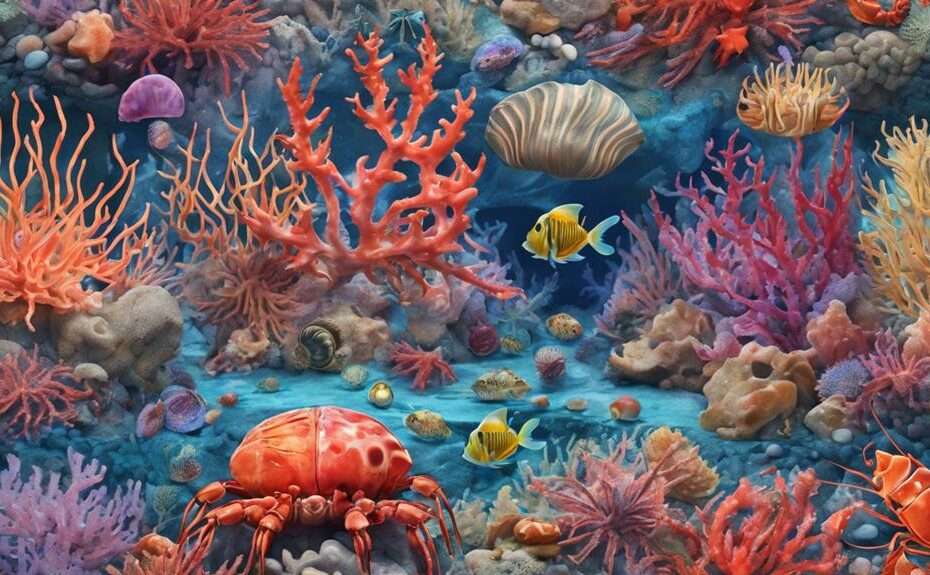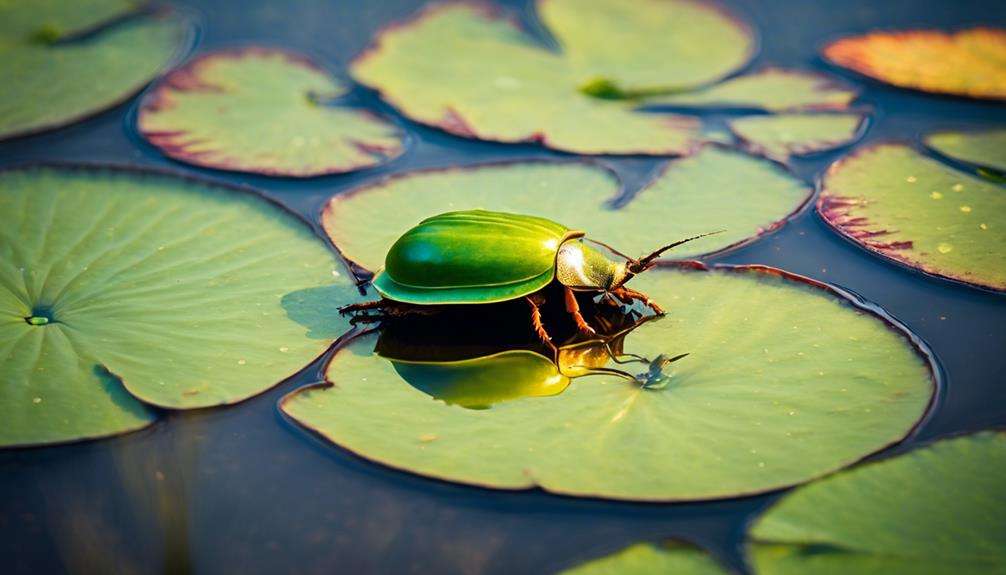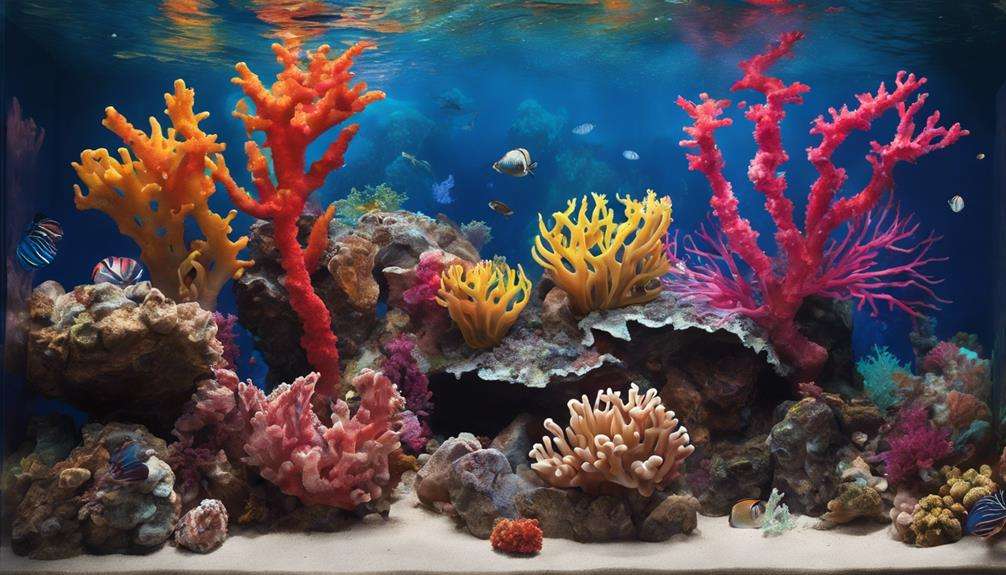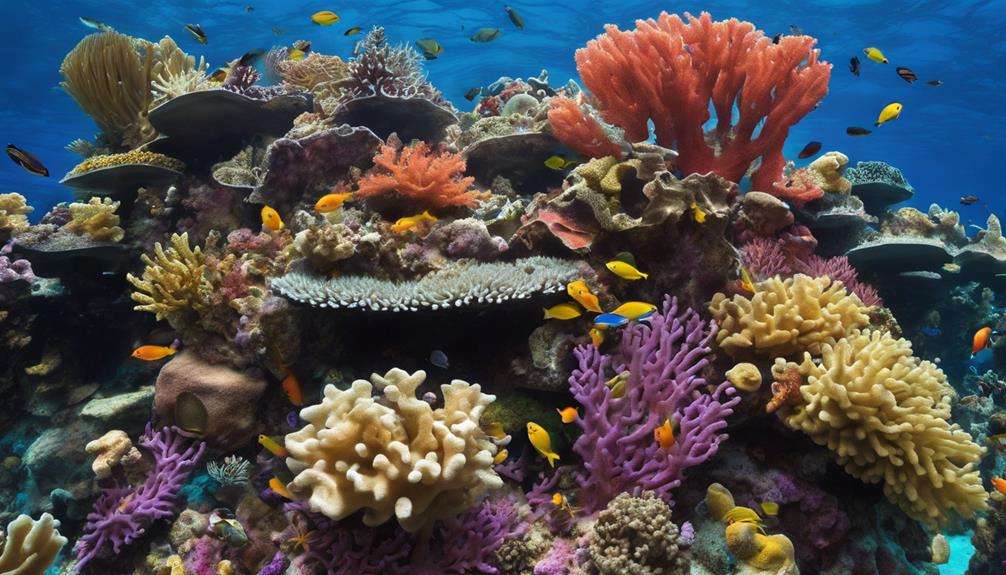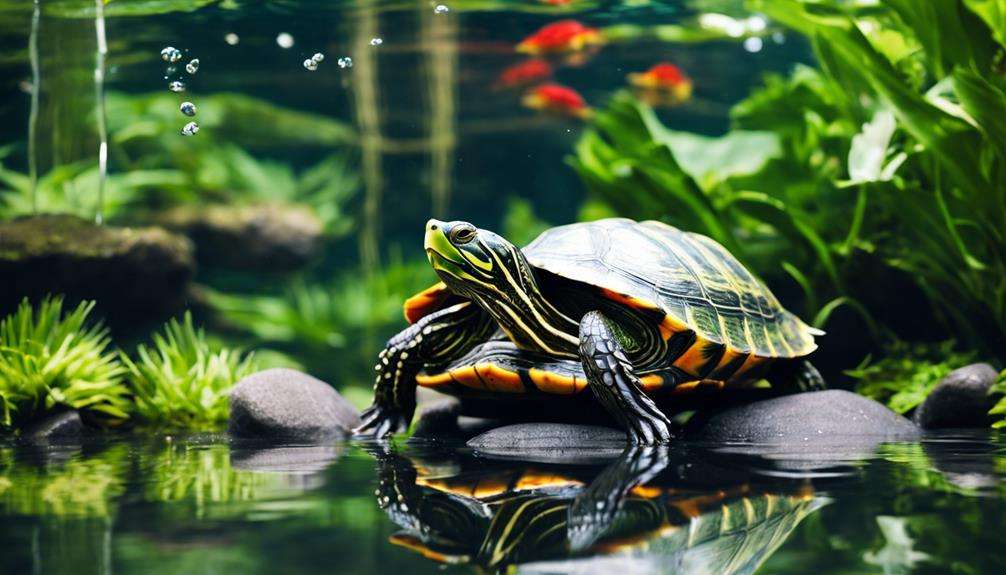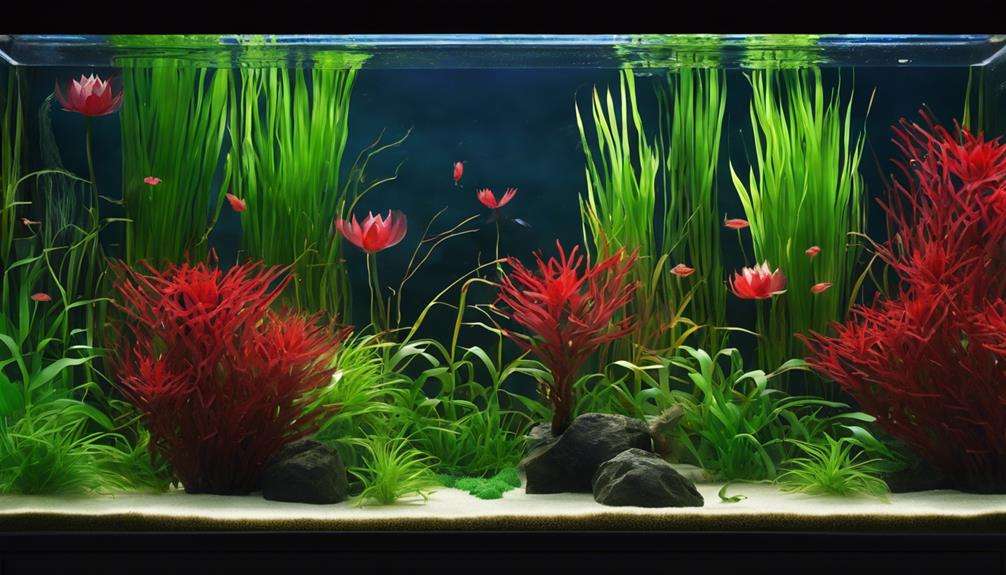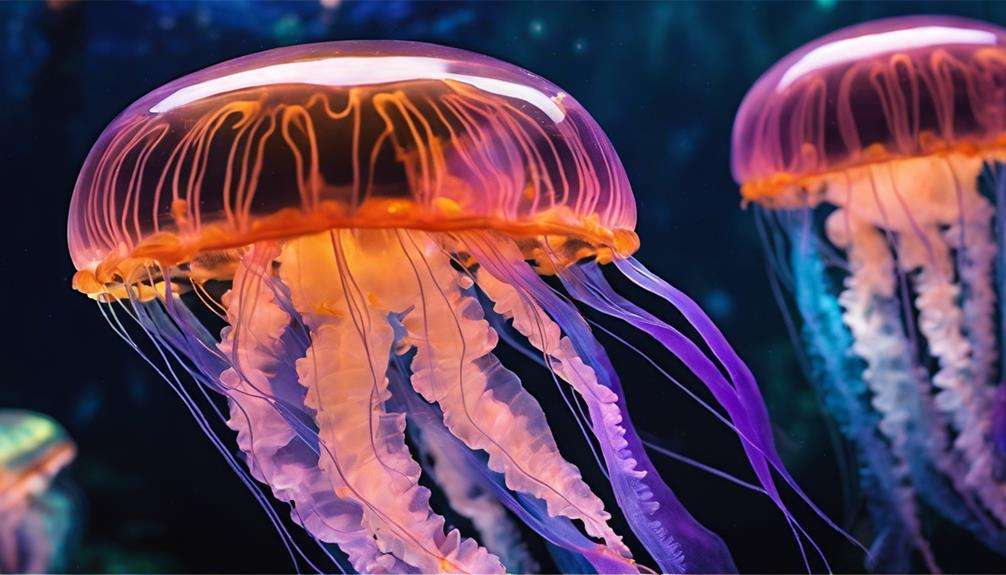Imagine your marine tank as a thriving underwater ecosystem, a miniaturized world where fascinating creatures like the Peppermint Shrimp and Mantis Shrimp can captivate your attention.
These crustaceans bring not only visual appeal but also unique behaviors that can add a dynamic element to your tank.
As you observe these creatures in action, you'll discover a whole new dimension to your aquatic environment, making it a truly mesmerizing experience.
Key Takeaways
- Peppermint Shrimp and Aiptasia Hunters clean tanks at night, vital for tank health.
- Mantis Shrimp are aggressive hunters, challenging to keep due to disruptive nature.
- Spider Decorator Crab excels in camouflage, enhancing tank aesthetics with unique character.
- Pom-Pom Crab carries anemones, requires specific diet, suitable for nano tanks.
Peppermint Shrimp
Have you ever wondered about the fascinating nocturnal habits of Peppermint Shrimp in maintaining the cleanliness of your marine tank? Peppermint Shrimp, scientifically known as members of the Hippolytidae family and native to the Caribbean Sea, are a sight to behold. These Candy Crane Shrimp, as they're also called, are small semi-transparent creatures with striking reddish exoskeletons and red lines, reaching sizes of up to 2 inches.
Peppermint Shrimp are nocturnal feeders, making them efficient cleaners in your tank. They help uphold tank hygiene by diligently feeding on debris and detritus, ensuring a healthier environment for your marine life. During the day, these shrimp instinctively hide from predators, a behavior that aids in their survival. They undergo molting to grow, shedding their old exoskeleton. Curiously, after molting, they consume their discarded shell to replenish calcium levels. These fascinating crustaceans play a vital role in maintaining the balance within your tank ecosystem.
Aiptasia Hunters
Peppermint Shrimp, known for their adept hunting skills and nocturnal behavior, serve as effective aiptasia hunters in marine tanks. These nighttime hunters are natural predators of aptasia anemones, aiding in controlling these pests that can harm coral reefs. Keeping Peppermint Shrimp in groups is recommended for more efficient aptasia control in aquariums. Their nocturnal nature means they actively hunt at night and hide during the day, making them valuable assets in maintaining the balance of the marine tank ecosystem.
In the marine environment, Peppermint Shrimp play a vital role in controlling aptasia populations, contributing to the overall health and cleanliness of the aquarium. By keeping these beneficial additions in your tank, you're helping to guarantee a stable and thriving marine ecosystem. With their specialized hunting abilities and preference for nighttime activity, Peppermint Shrimp offer a natural and effective solution for managing aptasia in marine tanks.
Mantis Shrimp
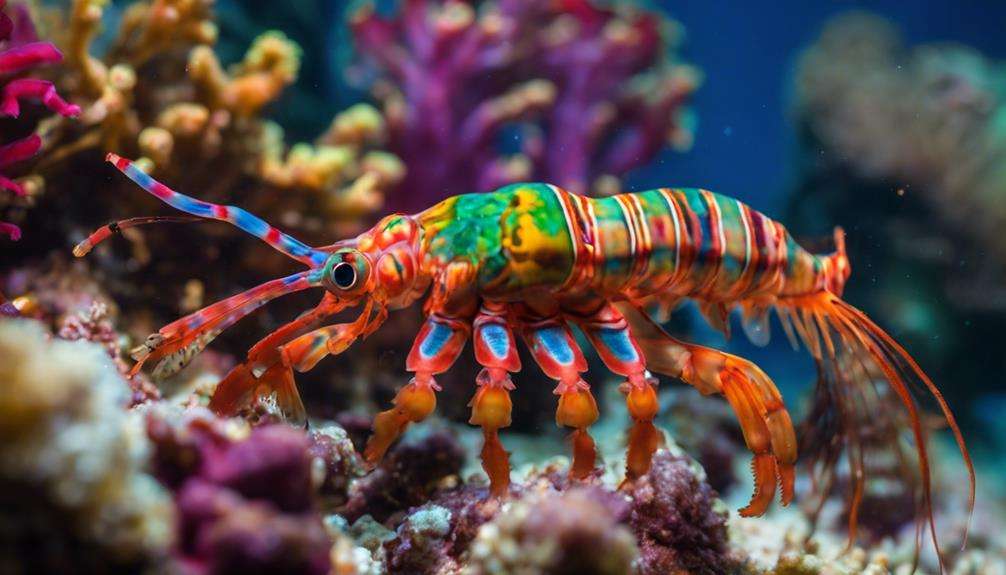
Mantis shrimp, belonging to the aggressive stomatopod species distantly related to lobsters and crabs, are renowned for their formidable claws capable of slicing or smashing prey with astonishing force. These fascinating creatures, often described as 'Shrimp from Mars' due to their alien-like appearance, exhibit aggressive behavior that can make them challenging to keep in marine tanks. Their hunting techniques are as unique as they're deadly, with some species even capable of breaking aquarium glass with their powerful claws.
While the mantis shrimp's striking colors and interesting behaviors may make them tempting additions to your tank, their disruptive nature towards other tank mates should be carefully considered. These stomatopod species are known for their territorial tendencies and can quickly turn a peaceful tank environment into a battleground. If you're willing to accommodate their needs and provide a suitable habitat, observing these incredible creatures in action can be a thrilling experience for any marine enthusiast.
Spider Decorator Crab
The Spider Decorator Crab showcases remarkable camouflage expertise, seamlessly blending into marine tank environments with its intricate patterns and colors. This crab's unique ability to disguise itself adds character and natural behavior to marine aquariums. Its exceptional camouflage skills and artistic appearance make it a fascinating invertebrate species.
By mimicking natural environments, Spider Decorator Crabs contribute to the aesthetics of the tank, adding visual interest. These crabs stand out by attaching algae and soft coral polyps to their shells, creating a stunning and dynamic display in aquariums. Their ability to adorn themselves with these elements not only aids in their camouflage but also enhances the overall beauty of the tank.
Observing the Spider Decorator Crab in a marine aquarium isn't only educational but also visually enthralling, offering a glimpse into the intricate ways in which these creatures interact with their surroundings.
Pom-Pom Crab
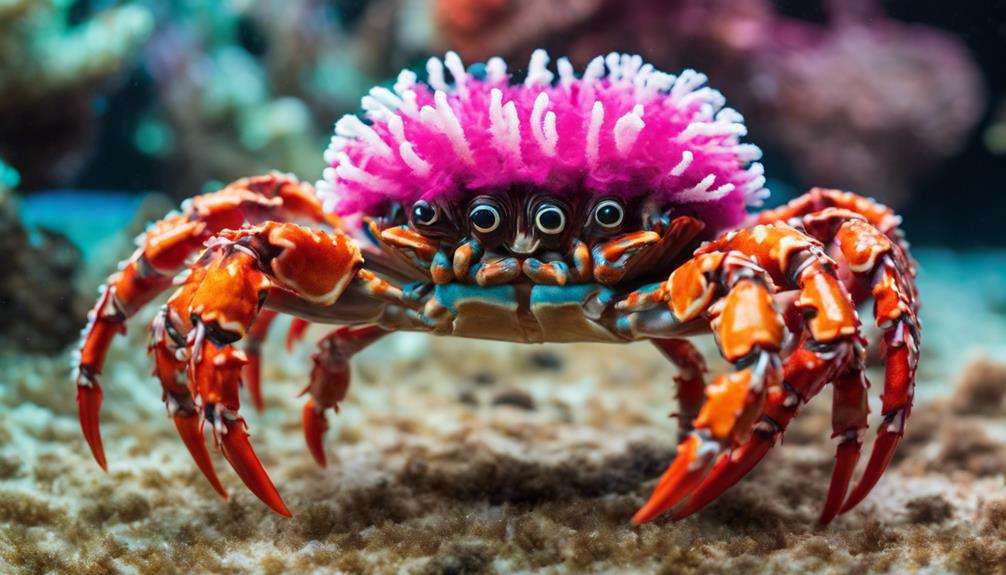
With their unique defense mechanism of carrying anemones on their claws, Pom-Pom crabs enhance the ecosystem of marine tanks while showcasing distinctive features. These crabs play a crucial role in cleaning aquariums by diligently picking off debris and detritus from various surfaces, contributing to the overall health of the tank. Pom-Pom crabs sport a striking appearance with white to tan coloring and darker markings on their bodies, adding visual interest to the tank environment. Their relatively small size makes them a perfect fit for nano aquariums and smaller setups, where they can thrive and exhibit their fascinating behaviors.
To guarantee the well-being of Pom-Pom crabs in captivity, it's essential to supplement their diet with meaty foods, providing them with the necessary nutrients for vitality. By incorporating these unique crustaceans into your marine tank, you not only benefit from their cleaning abilities but also get to observe their engaging interactions with the anemones they carry, making them a delightful addition to any marine aquarium setup.
Frequently Asked Questions
What Are the Best Invertebrates for Marine Aquariums?
For marine aquariums, the top invertebrates comprise Trochus, Turbo, Cerith, Nassarius, and Conch Snails. They assist in algae control, sand bed aeration, and tank maintenance. Make certain proper acclimation for their health and your tank's balance.
What Are the Tiny Crustaceans in My Saltwater Tank?
In your saltwater tank, you may find mysterious copepods, intriguing amphipods, hidden isopods, tiny mysids, curious ostracods, enigmatic tanaids, unseen cumaceans, puzzling branchiopods, secretive copepods, and unknown euphausiids. These tiny crustaceans play important roles in your marine ecosystem.
What Are the Tiny Shrimp in My Marine Tank?
In your marine tank, the tiny shrimp exhibit fascinating behavior. They necessitate proper care, specific tank setup, and water parameters. Peppermint Shrimp, nocturnal with molting habits, vary in color. Guarantee suitable tank mates and feeding to support their well-being.
Are Snails or Hermit Crabs Better for Reef Tanks?
In reef tanks, snails and hermit crabs play vital roles in maintaining cleanliness, but each has unique benefits. Snails excel at algae control, while hermit crabs scavenge detritus. Consider your tank's needs and compatibility when choosing your cleaning crew.
Conclusion
Congratulations on adding these fascinating crustaceans to your marine tank! Your tank will surely be enriched with the unique behaviors and characteristics of the Peppermint Shrimp, Aiptasia Hunters, Mantis Shrimp, Spider Decorator Crab, and Pom-Pom Crab.
Just be prepared for the unexpected challenges that may arise, especially with the Mantis Shrimp's aggressive nature.
Remember, in the world of marine tanks, sometimes the most fascinating creatures can also be the most unpredictable!
